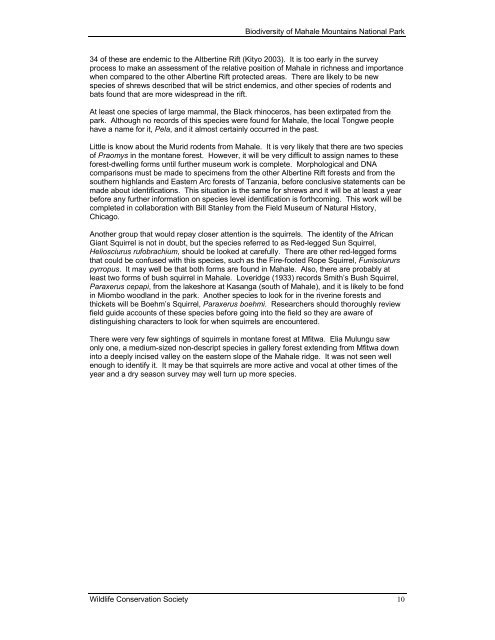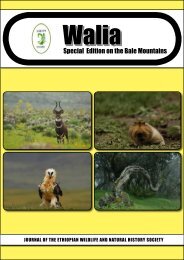Biodiversity of Mahale Mountains National Park, Tanzania | Report ...
Biodiversity of Mahale Mountains National Park, Tanzania | Report ...
Biodiversity of Mahale Mountains National Park, Tanzania | Report ...
You also want an ePaper? Increase the reach of your titles
YUMPU automatically turns print PDFs into web optimized ePapers that Google loves.
<strong>Biodiversity</strong> <strong>of</strong> <strong>Mahale</strong> <strong>Mountains</strong> <strong>National</strong> <strong>Park</strong><br />
34 <strong>of</strong> these are endemic to the Altbertine Rift (Kityo 2003). It is too early in the survey<br />
process to make an assessment <strong>of</strong> the relative position <strong>of</strong> <strong>Mahale</strong> in richness and importance<br />
when compared to the other Albertine Rift protected areas. There are likely to be new<br />
species <strong>of</strong> shrews described that will be strict endemics, and other species <strong>of</strong> rodents and<br />
bats found that are more widespread in the rift.<br />
At least one species <strong>of</strong> large mammal, the Black rhinoceros, has been extirpated from the<br />
park. Although no records <strong>of</strong> this species were found for <strong>Mahale</strong>, the local Tongwe people<br />
have a name for it, Pela, and it almost certainly occurred in the past.<br />
Little is know about the Murid rodents from <strong>Mahale</strong>. It is very likely that there are two species<br />
<strong>of</strong> Praomys in the montane forest. However, it will be very difficult to assign names to these<br />
forest-dwelling forms until further museum work is complete. Morphological and DNA<br />
comparisons must be made to specimens from the other Albertine Rift forests and from the<br />
southern highlands and Eastern Arc forests <strong>of</strong> <strong>Tanzania</strong>, before conclusive statements can be<br />
made about identifications. This situation is the same for shrews and it will be at least a year<br />
before any further information on species level identification is forthcoming. This work will be<br />
completed in collaboration with Bill Stanley from the Field Museum <strong>of</strong> Natural History,<br />
Chicago.<br />
Another group that would repay closer attention is the squirrels. The identity <strong>of</strong> the African<br />
Giant Squirrel is not in doubt, but the species referred to as Red-legged Sun Squirrel,<br />
Heliosciurus rufobrachium, should be looked at carefully. There are other red-legged forms<br />
that could be confused with this species, such as the Fire-footed Rope Squirrel, Funisciururs<br />
pyrropus. It may well be that both forms are found in <strong>Mahale</strong>. Also, there are probably at<br />
least two forms <strong>of</strong> bush squirrel in <strong>Mahale</strong>. Loveridge (1933) records Smith’s Bush Squirrel,<br />
Paraxerus cepapi, from the lakeshore at Kasanga (south <strong>of</strong> <strong>Mahale</strong>), and it is likely to be fond<br />
in Miombo woodland in the park. Another species to look for in the riverine forests and<br />
thickets will be Boehm’s Squirrel, Paraxerus boehmi. Researchers should thoroughly review<br />
field guide accounts <strong>of</strong> these species before going into the field so they are aware <strong>of</strong><br />
distinguishing characters to look for when squirrels are encountered.<br />
There were very few sightings <strong>of</strong> squirrels in montane forest at Mfitwa. Elia Mulungu saw<br />
only one, a medium-sized non-descript species in gallery forest extending from Mfitwa down<br />
into a deeply incised valley on the eastern slope <strong>of</strong> the <strong>Mahale</strong> ridge. It was not seen well<br />
enough to identify it. It may be that squirrels are more active and vocal at other times <strong>of</strong> the<br />
year and a dry season survey may well turn up more species.<br />
Wildlife Conservation Society 10
















